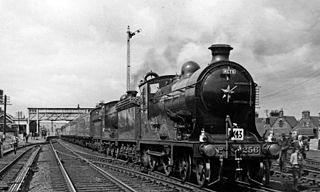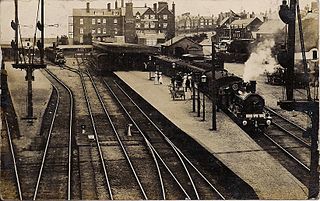Related Research Articles

The North British Railway was a British railway company, based in Edinburgh, Scotland. It was established in 1844, with the intention of linking with English railways at Berwick. The line opened in 1846, and from the outset the company followed a policy of expanding its geographical area, and competing with the Caledonian Railway in particular. In doing so it committed huge sums of money, and incurred shareholder disapproval that resulted in two chairmen leaving the company.

The Waverley Route was a railway line that ran south from Edinburgh, through Midlothian and the Scottish Borders, to Carlisle. The line was built by the North British Railway; the stretch from Edinburgh to Hawick opened in 1849 and the remainder to Carlisle opened in 1862. The line was nicknamed after the immensely popular Waverley Novels, written by Sir Walter Scott.
The City of Glasgow Union Railway - City Union Line, also known as the Tron Line, was a railway company founded in Glasgow, Scotland, in 1864 to build a line connecting the railway systems north and south of the River Clyde, and to build a central passenger terminus and a general goods depot for the city. The through line, running from south-west to north-east across the city, opened in 1870–71, and the passenger terminal was St Enoch railway station, opened in 1876. The railway bridge across the Clyde was the first in the city.

The Edinburgh and Dalkeith Railway was an early railway built to convey coal from pits in the vicinity of Dalkeith into the capital. It was a horse-operated line, with a terminus at St Leonards on the south side of Arthur's Seat.

Mangotsfield railway station was a railway station on the Midland Railway route between Bristol and Birmingham, 5 miles (8.0 km) north-east of Bristol Temple Meads and 82 miles (132 km) from Birmingham New Street, serving the village of Mangotsfield in South Gloucestershire, England. The station was opened in 1845 by the Bristol and Gloucester Railway, but had very little in the way of passenger amenities. The station was resited in 1869 to serve the new Mangotsfield and Bath Branch Line, and became an important junction station with extensive facilities and six platforms. Passenger footfall however failed to match the station's size, though at its peak eight staff were employed. The station closed in 1966 when services to Bath ended as part of the Beeching cuts, and the line through the station closed in 1969. The railway became a cycle path in the 1980s, and is a popular resting point on the route as several of the station's walls and platforms are still in situ.
The Border Counties Railway was a railway line connecting Hexham in Northumberland, with Riccarton Junction on the Waverley Route in Roxburghshire.

Hunstanton railway station served the seaside town of Hunstanton in Norfolk, England. Opened in 1862, the station was the northern terminus of the Lynn and Hunstanton Railway. The line was brought to public notice by John Betjeman in the British Transport Film John Betjeman Goes By Train. The station closed with the line in 1969.

North Wootton was a railway station on the King's Lynn to Hunstanton line which opened in 1862 to serve the village of North Wootton on the outskirts of King's Lynn in Norfolk, England. The station closed along with the line in 1969.
The Wansbeck Railway was a single-track railway line in Northumberland, England, that ran from Morpeth to Reedsmouth, where it made a junction with the Border Counties Railway. Conceived as part of a through trunk route for the North British Railway, it never achieved its potential. It opened in stages from 1862 to 1865. The population was sparse and mineral traffic kept the line going.

Belses railway station served the village of Belses, Scottish Borders, Scotland from 1849 to 1969 on the Waverley Route.

Hawick railway station served the town of Hawick, Scottish Borders, Scotland from 1849 to 1969 on the Waverley Route.
Stobs railway station served the hamlet of Barnes, Scottish Borders, Scotland from 1862 to 1969 on the Border Union Railway.

Shankend railway station served the hamlet of Shankend, Scottish Borders, Scotland from 1862 to 1969 on the Border Union Railway.

Newcastleton railway station served the village of Newcastleton, Scottish Borders, Scotland from 1862 to 1969 on the Border Union Railway.

Kershope Foot railway station served the hamlet of Kershopefoot, Cumbria, from 1862 to 1969 on the Border Union Railway.
Penton railway station served the parish of Penton from 1862 to 1969 on the Border Union Railway.
The St Andrews Railway was an independent railway company, founded in 1851 to build a railway branch line from the university town of St Andrews, in Fife, Scotland, to the nearby main line railway. It opened in 1852. When the Tay Rail Bridge opened in 1878 residential travel to Dundee was encouraged.

The Banff, Macduff and Turriff Junction Railway was a railway company that connected the Aberdeenshire town of Turriff with the main line of the Great North of Scotland Railway (GNoSR) at Inveramsay. It had earlier been intended to reach Macduff, but shortage of finance forced curtailment. It opened its line in 1857.

The Lynn and Hunstanton Railway was a line in Norfolk, England that opened in 1862. The railway was a major factor in developing Hunstanton as a seaside resort and residential community. The company was allied to the West Norfolk Junction Railway which built a line connecting Heacham, south of Hunstanton, to Wells-next-the-Sea that was not a financial success. The companies amalgamated in 1874 to form the Hunstanton and West Norfolk Railway, and in 1890 the company was sold to the Great Eastern Railway.
References
- ↑ "Steele Road Station". Disused Stations. Retrieved 28 August 2020.
- Quick, M E (2002). Railway passenger stations in England, Scotland and Wales - a chronology. Richmond: Railway and Canal Historical Society. p. 378. OCLC 931112387. - ↑ Williamson, Kenneth G. (10 September 2018). "Fatal Accident at Steele Road Station". Railway Work, Life & Death. Retrieved 3 May 2024.
{{cite web}}: CS1 maint: url-status (link)
| Preceding station | Historical railways | Following station | ||
|---|---|---|---|---|
| Riccarton Junction Line and station closed | Border Union Railway | Newcastleton Line and station closed | ||